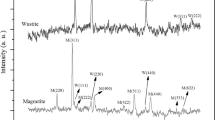Abstract
Mössbauer spectroscopy studies of iron catalysts from a Fischer-Tropsch (FT) Pilot Plant run at different time-on-stream periods were carried out. Magnetite Fe3O4 was found to be active for the water-gas-shift (WGS) reaction which accompanies the FT synthesis reaction over Fe-based catalysts. A correlation between the ratio of the occupancy of octahedral sites to the tetrahedral sites in magnetite to the WGS activity was found. Cation-deficient magnetite gave higher WGS activity as compared to the stoichiometric phase.
Similar content being viewed by others
References
B.L. Bhatt, E.S. Schaub, E.C. Heydorn, D.M. Herron, D.W. Studer and D.M. Brown,Proc. DOE Liquefaction Contractors Review Conf., Pittsburg, September 1992.
G.A. Sawatzky, F. van der Woude and A.H. Morrish, Phys. Rev. 183(1969)383.
D.G. Rethwisch and J.A. Dumesic, Appl. Catal. 21(1986)97.
D.G. Rethwisch and J.A. Dumesic, J. Catal. 101(1986)35.
Author information
Authors and Affiliations
Rights and permissions
About this article
Cite this article
Rao, K.R.P.M., Huggins, F.E., Mahajan, V. et al. The role of magnetite in Fischer-Tropsch synthesis. Hyperfine Interact 93, 1745–1749 (1994). https://doi.org/10.1007/BF02072939
Issue Date:
DOI: https://doi.org/10.1007/BF02072939




